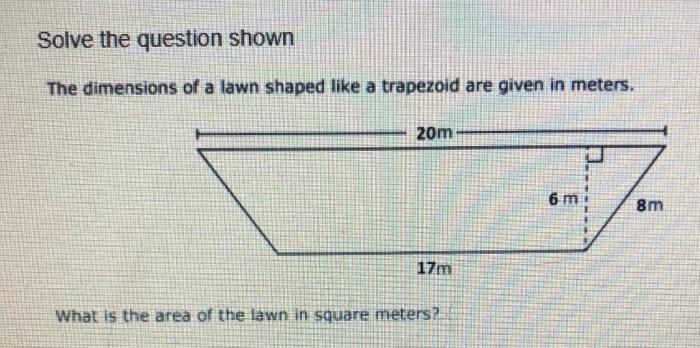Jamal’s lawn is shaped like a square – Jamal’s lawn, meticulously shaped into a perfect square, presents a unique canvas for landscaping artistry. This precisely defined space invites creativity and innovation, offering endless possibilities to transform an ordinary lawn into an extraordinary outdoor haven.
With its clean lines and symmetrical proportions, Jamal’s lawn serves as an ideal backdrop for a wide range of landscaping designs. From vibrant flowerbeds to tranquil water features, the square shape provides a harmonious framework for creating a cohesive and visually appealing outdoor space.
Shape of Jamal’s Lawn

Jamal’s lawn is shaped like a square, which is a two-dimensional shape with four equal sides and four right angles.
Visual Representation, Jamal’s lawn is shaped like a square
The following table provides a visual representation of Jamal’s lawn using HTML table tags:
Area and Perimeter of the Lawn: Jamal’s Lawn Is Shaped Like A Square

The area of a square is calculated by squaring its side length. The perimeter of a square is calculated by multiplying its side length by 4.
Area of the Lawn
Since Jamal’s lawn is a square, the area can be calculated as follows:
Area = side length2
Given that the side length of the lawn is 20 meters, the area of the lawn is:
Area = 202= 400 square meters
Perimeter of the Lawn
Similarly, the perimeter of Jamal’s lawn can be calculated as follows:
Perimeter = 4 × side length
Therefore, the perimeter of the lawn is:
Perimeter = 4 × 20 = 80 meters
Landscaping Options for Jamal’s Lawn

The square shape of Jamal’s lawn provides a versatile canvas for various landscaping designs. Here are some ideas and elements that complement the lawn’s geometry:
Plant Selection
- Formal Plants:Boxwood, holly, and yews create clean lines and geometric shapes that echo the square lawn’s form.
- Native Plants:Consider local wildflowers, grasses, and shrubs that attract pollinators and enhance biodiversity.
- Flowering Perennials:Plant a variety of perennials, such as daisies, lilies, and lavender, to add color and texture to the lawn.
Design Elements
- Symmetry:Arrange plants and features symmetrically around the lawn’s central axis to create a balanced and visually appealing design.
- Focal Points:Create a focal point in the center of the lawn, such as a fountain, statue, or large tree, to draw the eye and provide interest.
- Paths and Walkways:Incorporate paths and walkways made of brick, stone, or gravel to create a sense of movement and divide the lawn into sections.
Landscaping Options Table
| Option | Advantages | Disadvantages |
|---|---|---|
| Formal Plants | – Create clean lines and geometric shapes
|
– Can be expensive
|
| Native Plants | – Attract pollinators and enhance biodiversity
|
– May not provide year-round interest
|
| Flowering Perennials | – Add color and texture to the lawn
|
– Require more maintenance
|
| Symmetry | – Creates a balanced and visually appealing design
|
– Can be rigid and inflexible
|
| Focal Points | – Draws the eye and provides interest
|
– Can be expensive to install
|
| Paths and Walkways | – Creates a sense of movement and divides the lawn into sections
|
– Can be expensive to install
|
Mowing and Maintenance of Jamal’s Lawn

Maintaining a square-shaped lawn requires specific mowing patterns and techniques to ensure optimal health and appearance. This involves following a consistent mowing schedule, employing proper techniques, and implementing effective maintenance practices.
Regular mowing is crucial for promoting healthy lawn growth and preventing the accumulation of thatch, a layer of dead grass that can suffocate the lawn. Mowing at the appropriate height and frequency is essential to maintain the lawn’s vigor and aesthetic appeal.
Optimal Mowing Pattern
For a square-shaped lawn, a straight-line mowing pattern is recommended to achieve a uniform cut. Begin by mowing one side of the lawn in straight lines, then turn and mow perpendicular to the first set of lines. Continue this pattern until the entire lawn is mowed.
Mowing Frequency
The frequency of mowing depends on the growth rate of the grass species and the desired height of the lawn. As a general rule, mow when the grass reaches one-third to one-half its desired height. For most lawns, mowing every 7-10 days is sufficient.
Mowing Techniques
Employing proper mowing techniques is essential to maintain the health of the lawn. These techniques include:
- Sharpen the mower blade regularly:A sharp blade ensures a clean cut, reducing the risk of tearing or damaging the grass blades.
- Mow at the correct height:The ideal mowing height varies depending on the grass species, but generally, most lawns should be mowed to a height of 2.5-3 inches.
- Avoid scalping the lawn:Scalping occurs when too much of the grass blade is removed, damaging the plant and making it more susceptible to disease.
- Alternate mowing directions:Alternating the direction of mowing helps prevent ruts and promotes even growth.
- Leave grass clippings on the lawn:Grass clippings provide nutrients to the lawn and help retain moisture.
Lawn Maintenance
In addition to mowing, regular maintenance practices are essential for maintaining a healthy and attractive lawn. These practices include:
- Watering:Water the lawn deeply and infrequently, allowing the water to penetrate the soil to the roots. Avoid overwatering, as this can lead to shallow root growth and disease.
- Fertilizing:Fertilize the lawn according to the soil test results and the recommended schedule for the grass species. Proper fertilization promotes healthy growth and resistance to pests and diseases.
- Aerating:Aeration helps improve drainage and air circulation in the soil, reducing compaction and promoting root growth. Aerate the lawn annually or as needed.
- Thatch control:Excessive thatch can prevent water and nutrients from reaching the soil. Dethatch the lawn as needed to remove excess thatch.
Query Resolution
What is the best way to mow a square lawn?
To achieve a clean and professional-looking cut, mow in straight lines, alternating the direction each time to prevent ruts. Overlapping your passes slightly will ensure an even cut.
What types of plants are best suited for a square lawn?
Square lawns complement a variety of plant choices. Consider incorporating evergreen shrubs to provide structure, colorful perennials for seasonal interest, and groundcovers to fill in empty spaces and suppress weeds.
How often should I water my square lawn?
Watering needs vary depending on factors such as climate and soil type. As a general rule, water deeply and infrequently, allowing the soil to dry out slightly between watering sessions.

